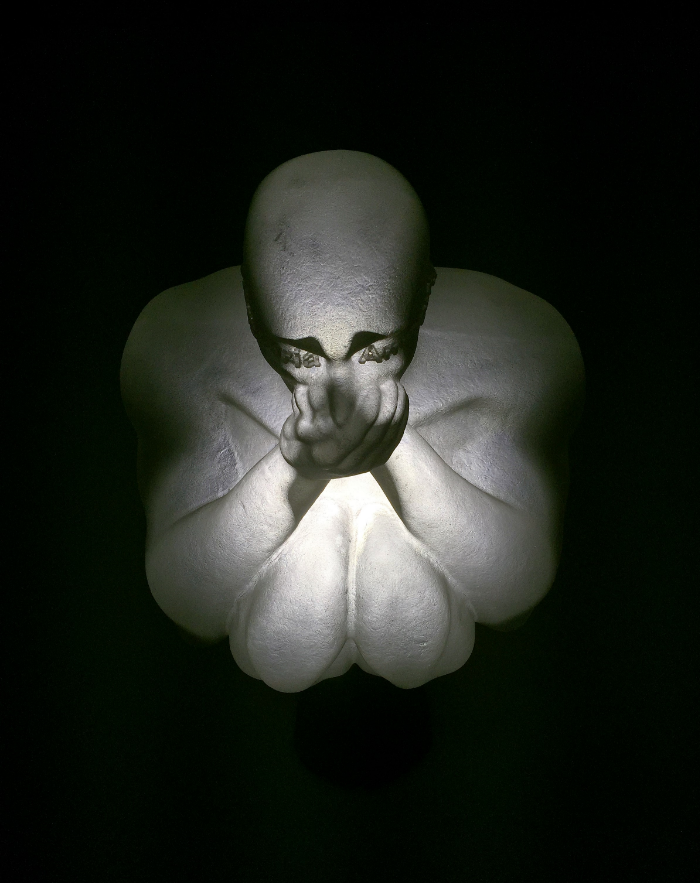Jaume Plensa: Please be careful when walking through this artwork...
We have much more in common than we think. Borders, flags, nationalities are more an invention than a real thing. Art has a tremendous capacity to build bridges between us. - Jaume Plensa
Speak No Evil, Jaume Plensa
Please be careful walking through this artwork...you just might love it.
This title phrase belongs to the Tampa Museum of Art artist label for Jaume Plensa's, Silent Rain, pictured near the end of this post. The "you might love it" is mine. Indeed, I am sure most visitors to the museum will enjoy this artwork. Gauging by social media posts, many visited the show over Valentine's Day weekend. I am excited this artwork is here.
The show is Jaume Plensa: Human Landscape. Jaume Plensa is a Spanish artist, born in Barcelona, internationally known and recognized. He has created artwork related to the human figure, immense in scale, that is and has been exhibited around the world in public spaces and museums. His sculptures, some of those that are immense in scale, are positioned inside and outside the Tampa Museum. Plensa's artworks feature "multilingual text-based imagery and the simple human form — which he calls a funny kind of container — to create a universal visual language that hurdles cultural boundaries and unites people around the world."
Plensa believes his sculptures "act as respites within their surroundings; conduits for meditation and reflection. I've always tried to generate silence in my work. We are in a noisy period of time, we hardly know if our words are our own or just an echo. He dreams of someone standing in front his work and not necessarily seeing a sculpture, but seeing themselves reflected so that they must turn inward and begin to search for beauty there."
The Soul of Words 1, Jaume Plensa
The artwork included in the Human Landscape titled exhibition may be exhibited indoors or outdoors depending on the venue environment and public spaces. At the Tampa Museum, visitors can engage with some of the artwork whether the museum is open or closed.
I first saw this work last summer in Nashville's Frist Center for the Visual Arts, part of a cross-city exhibition of his work. Plensa's See No Evil, Hear No Evil and Speak No Evil were on view and contained in a smaller space than allowed at the Tampa Museum. I wrote: "Jaume Plensa's figures stole most of my attention. Large in scale, some pieces over seven feet high, his sculptures are transfixing. The three immense figures are illuminated and superimposed with representative words. The effect was alternatively distressing and transformative, certainly mesmerizing." At the Tampa Museum there is more room to explore these figures, even space for seating. Visitors are encouraged to consider how unwilling we are "to say the right words....How many times our mouth is not saying the word that we would have said, our eyes cannot express our real intentions, or our ears are sealed to listen..."
Here, where all of the works are together, the next room contains Awilda and Irma, a consideration of outer and inner beauty. These immense stainless steel "mesh" sculptures were placed in a pond at the Cheekwood Botanical Gardens in Nashville. At the Tampa Museum, visitors can touch the sculptures. Rub them and you will feel the vibration of the metal.
Awilda and Irma, Jaume Plensa
Rubbing the sculptures was a tip passed on by the guard on duty, who was enjoying the artwork as much as the visitors. He carefully dusted the nose of this artwork, and moved over to gently untangle the words of Silent Rain.
He offered as much insight as a docent, sharing with us the viewing tips for Silent Rain, the first in a series of works in which Plensa combines poems into curtains of vertical lines of text. Before you explore the artwork, pictured below, note the text is not the horizontal, left to right format of Western tradition, but rearranged in vertical strands of letters "seemingly falling down like rain drops."
Silent Rain, Jaume Plensa
The guard shared you must read from the top left, down and continue over to the right. The words are continuous and flow through multiple languages: English, French, German, Macbeth, Italian and Spanish. Visitors can walk through the strands of words, challenge their reading skills and see the reflection of words against the floors and walls.
As we walked on, I wished I had captured the name of the guard; he was a wonderful ambassador for the museum. The entire museum staff seemed engaged in this exhibition. The front desk noticed my camera and encouraged me to photograph the artwork.
I believe the new Tampa Museum director, Michael Tomor, has brought new energy, new life to the museum. A recent acquisition, Simply Beautiful, a mixed media installation of flowers and bicycle wheels which engage by motion detector - produced by Mabel Poblet Pujols - has livened up the lobby and the gift shop was bustling. It feel alive in there. I renewed my membership.
The exhibition of Plensa's artwork is beautiful. It is touchable, engaging, understandable and conveys a wonderful message. Perhaps it is particularly germane for today's sometimes contentious times.
I leave you with the artists words: "I don't feel you have to travel thousands of miles to understand human beings. I guess the most important thing is to try to understand yourself first, then you can probably understand others much better. We have much more in common than we think. Borders, flags, nationalities are more an invention than a real thing. Art has a tremendous capacity to build bridges."





